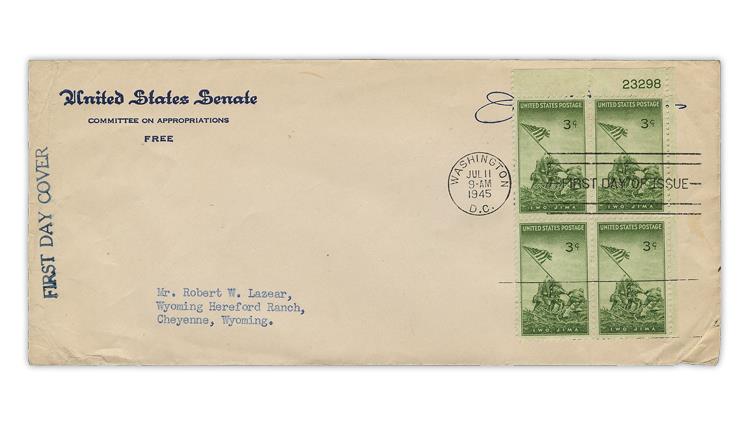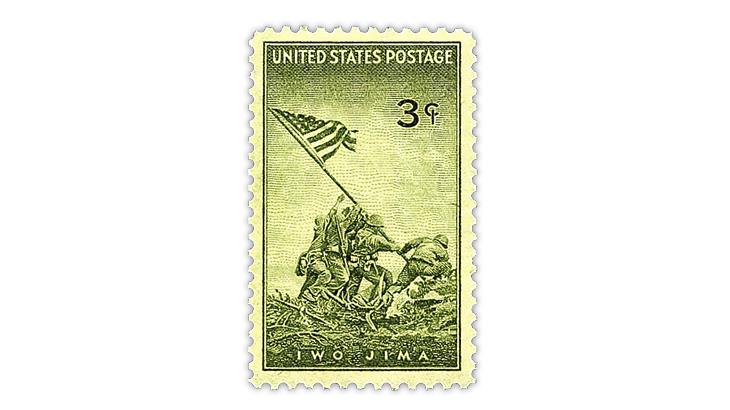US Stamps
Wyoming senator championed the 1945-46 Armed Forces series
U.S. Stamp Notes by John M. Hotchner
On July 11, 1945, the Post Office Department issued the first of five stamps to honor the heroism and sacrifices of members of the armed forces of the United States during World War II. Figure 1 shows a first-day cover for this vertical 3¢ stamp honoring the U.S. Marines.
The stamp is pictured in Figure 2. It used as its central design a reproduction of Associated Press photographer Joseph Rosenthal’s photo of the raising of the American flag on Mount Suribachi on the western Pacific island of Iwo Jima on Feb. 23, 1945.
Another month of fighting was needed before the island was secured, but taking the high point of the island marked a turning point in the Battle of Iwo Jima.
This stamp was a victory for Sen. Joseph C. O’Mahoney, a former first assistant postmaster general (March-December 1933). Just months after Postmaster General James Farley had appointed him to that position, the governor of Wyoming, Leslie A. Miller, appointed him to fill a vacant seat in the U.S. Senate. In 1934 O’Mahoney was elected to the Senate for a full term.
He was among the many people and groups suggesting stamps for the armed forces after America entered WWII, but no action was taken.
In 1945, when he saw the Rosenthal photo, O’Mahoney wrote to Postmaster General Frank C. Walker formally proposing an Armed Forces stamp series and noting the Rosenthal photo as especially appropriate for the Marine Corps stamp.
In March of that year, he also introduced a Congressional resolution, with 11 other senators co-sponsoring, authorizing the Armed Forces stamp series.
Their activism was rewarded on June 7, 1945, when the POD announced the Marine Corps stamp, crediting O’Mahoney’s initiative as the spark. A few days later, the POD announced that this stamp would be the first of an Armed Forces series.
Two days later, June 9, additional details of the Marine Corps stamp were reported, including the intended color: purple. This brought forth a cascade of criticism from people who wanted the U.S. flag to be shown in color. That was not possible given the Bureau of Engraving and Printing’s capabilities and the short timeline for printing.
But after reviewing many color samples, the POD changed the color to one similar to the forest green uniform worn by the Marines.
The FDC in Figure 1 was sent using O’Mahoney’s Senate stationery. Contained inside were a letter from the senator praising himself, the Marines and the POD on the occasion of the stamp’s first day, and a reprint of his speeches in the Senate advocating for the issue.
Figure 3 shows an FDC for another stamp in the series, the 3¢ blue Navy stamp issued Oct. 27, 1945 (Scott 935). The series also included tributes to the Army (Sept. 26, 1945, 934), the Coast Guard (Nov. 10, 1945, 936) and the Merchant Marine (Feb. 26, 1946, 939).
O’Mahoney went on to serve in the Senate with a short interruption in 1953-54, until 1961 when he retired.
Connect with Linn’s Stamp News:
Sign up for our newsletter
Like us on Facebook
Follow us on Twitter
MORE RELATED ARTICLES
Headlines
-
World Stamps
Oct 8, 2024, 3 PMRoyal Mail’s Oct. 1 definitive meets new international standard rate
-
World Stamps
Oct 8, 2024, 12 PMPostcrossing meetup Oct. 9 at U.N. headquarters
-
Postal Updates
Oct 7, 2024, 5 PMUSPS plans to raise postal rates five times in next three years
-
US Stamps
Oct 7, 2024, 3 PMMcMurtrie dismissed as APS education director following Sept. 21 arrest











